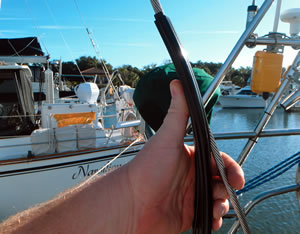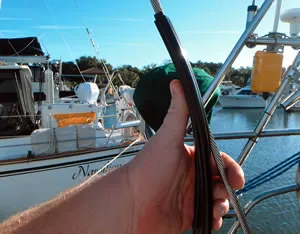
Bear with us here. Before you get too far into this months report on single-sideband radios beginning, youll find it is incomplete. There are a lot of unanswered questions that we hope to address. Answers don’t always come easy or fast in the work we do, but at the end of the day, we have to put out a magazine that reports our efforts.
We could, of course, just skip the work, glide around the Internet, type something up, and call it done. And you could use this to wrap your fish. If wed taken that approach, we would never have sent tester Capt. Frank Lanier out into the Atlantic with an SSB rig that defied all of the manufacturers recommendations. But we did. Thats how we roll.
To be clear: We are not super-enthusiastic about the antenna-counterpoise rig described in the article. As any engineer will point out, the same results could be achieved with far less investment. (At anchor, a roll of tinfoil tossed overboard can make a fine ground plane.) But we are very curious about it-even moreso now that weve spent some time with it.
What draws many users to SSB is the relatively inexpensive email connection using a PACTOR modem and the SailMail program. The makers of both these products-as well as the maker of the Icom M802 SSB radio that we used for testing-recommend a conventional antenna and ground system. But in this age when sailors expect plug-and-play satellite television, the idea of insulated backstays, copper foil counterpoise, etc., etc., seems, well-oh-so old school. So we forged ahead with some stuff that wasnt supposed to work, at least not very well.
First, we skipped the whole insulated backstay deal and installed the GAM/McKim split-lead antenna. Just slid it right up the backstay. Then-egads!-we bypassed the whole ground-plane/counterpoise step by installing the Radio-Teck KISS-SSB Grounding System, basically a bunch of shielded wires that you lay in the boat. Keep in mind some of the manufacturers participating the test had concerns about our setup. The GAM makers said they had not tested KISS grounding system (counterpoise) and recommended a more traditional grounding system. And Farallon, the U.S. distributor of the SCS DR-7400 Dragon we used, expressed strong doubts about both the GAM and the KISS.
Too much radio frequency interference (RFI) was the chief concern. The trouble is this: Closely spaced wires will couple RF energy from one to the other, and act as a single conductor depending on the spacing, frequency, and length.
Jim Corenman, a past PS contributor who wrote the SailMail program, spelled in out: The GAM risks coupling with the backstay it is attached to; and the separate wires inside the KISS will couple with each other, behaving as a single wire at RF frequencies, and radiating signal throughout the boat-where it does no good and just causes interference.
It took two days to install the gear, and another four months roaming the U.S. East Coast, the Atlantic, and the Bahamas to see how well it worked. Not once did Lanier have any trouble using the email function, and he saw nothing wrong with voice communications. To be honest, this was a surprise, particularly since Farallons engineer had said any deficiencies in the antenna system would be most obvious using email.
There is, of course, more to this story, and weve still got some work to do on the topic. Stay tuned.




































was there every a followup article? id sure like to know before i order those components. thanks.